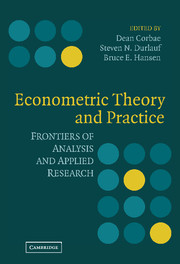Book contents
- Frontmatter
- Contents
- Preface: In Praise of a Remarkable Teacher
- Contributors
- Introduction
- PART I HIGHER-ORDER ASYMPTOTICS
- PART II IV SPECIFICATION TESTS
- PART III NONSTATIONARITY
- PART IV LAD AND QUANTILE REGRESSION
- 9 On Efficient, Robust, and Adaptive Estimation in Cointegrated Models
- 10 Testing Stationarity Using M-Estimation
- 11 Consistent Specification Testing for Quantile Regression Models
- PART V NONSTATIONARY PANELS
- Index
11 - Consistent Specification Testing for Quantile Regression Models
Published online by Cambridge University Press: 05 June 2012
- Frontmatter
- Contents
- Preface: In Praise of a Remarkable Teacher
- Contributors
- Introduction
- PART I HIGHER-ORDER ASYMPTOTICS
- PART II IV SPECIFICATION TESTS
- PART III NONSTATIONARITY
- PART IV LAD AND QUANTILE REGRESSION
- 9 On Efficient, Robust, and Adaptive Estimation in Cointegrated Models
- 10 Testing Stationarity Using M-Estimation
- 11 Consistent Specification Testing for Quantile Regression Models
- PART V NONSTATIONARY PANELS
- Index
Summary
INTRODUCTION
This chapter considers specification testing for a linear quantile regression model. The null hypothesis of interest is that the linear quantile regression function is correctly specified. The alternative hypothesis is the negation of the null hypothesis – that is, that the quantile regression function is not linear.
The tests we consider are generalizations of the Kolmogorov–Smirnov and Cramer–von Mises tests of goodness of fit. The tests can be applied to time series as well as cross-sectional contexts. The main characteristics of our tests are that they (i) are consistent against all alternatives to the null hypothesis, (ii) are powerful against alternatives, (iii) do not depend on any smoothing parameters, (iv) allow for data dependence, and (v) are simple to compute.
The quantile regression models have been increasingly popular in econometric applications in recent years. Examples include Chamberlain (1994), Buchinsky (1994, 1998), Poterba and Rueben (1994), Koenker and Geling (2001), Engle and Manganelli (2002), and Chernozhukov and Umantsev (2001). See also Koenker and Hallock (2001) for a recent survey and the special issue of Empirical Economics (2001, vol. 26). In contrast to mean regression models, quantile regression models impose less restrictions on the data, are robust to outliers in the data, and provide more complete information on conditional distributions of dependent variables.
- Type
- Chapter
- Information
- Econometric Theory and PracticeFrontiers of Analysis and Applied Research, pp. 288 - 308Publisher: Cambridge University PressPrint publication year: 2006
- 1
- Cited by



